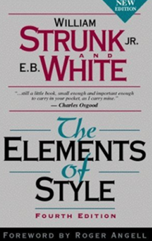Where Have You Gone, Ernest Hemingway?
Nov 20th, 2013 | By Lawrence B. Cahill | Category: Auditing, Environmental Management, Health and Safety“There is nothing to writing. All you do is sit down at a typewriter and bleed.”
— Ernest Hemingway
I’ve always thought that two of the most interesting challenges in one’s career as an EHS professional might be (1) to write an article on effective writing and (2) to give a presentation on effective public speaking. Talk about putting yourself on the firing line. With this brief article I will now have done both; so please be kind.
A good percentage of my responsibilities these days is devoted to reviewing reports, procedures, plans, and various other EHS compliance documents written by others. For the most part this has been a very rewarding, but at times frustrating, experience. I worry that the emergence of PowerPoint, Twitter, and texting is beginning to affect the writing capabilities of younger professionals. The shorthand limit of 140 characters with Twitter, in particular, has at times resulted in people forgetting, or ignoring, what they learned about writing in high school; things like the different parts of speech and that every sentence must have a subject, verb, and object.
I recall that as an engineering major in college, I was required to take a public speaking course but there was no available writing course directed at engineers, There was only freshman English, which consisted mostly of reading and discussing Dostoevsky and other famous writers, many of whom wrote their original manuscripts in their native language. Was I really reading Dostoevsky or some unknown ghost writer who was paid to translate the classic Crime and Punishment? I wonder what is required of engineers and scientists in college today. I hope it’s more than what was available to me. And I hope that the writing courses are not focused on how to write an effective PowerPoint bullet slide.
A Comparative Example
What has concerned me lately is what I have experienced in reviewing scores of findings in dozens of audit reports written by numerous auditors. Generally, findings are observations of a site’s compliance deficiencies and, as such, must be both factual and understandable. And most importantly, when read, a finding should be crystal clear on how best to correct the deficiency. Alas, this is not always the case. Let’s take the following example, which I recently came across in an audit report.
“Site not conducting weekly hazardous waste inspections, as required.”
Did that finding meet my expectations? It certainly did not and when I did a spell check, Word did not find it acceptable either (fragment). For one, it is not crystal clear. And if one reads the statement literally, it actually says that the requirement is to “not” conduct weekly inspections. In terms of the parts of speech, the statement is missing an article (“the”) and a verb, among other things. I’ve always believed that findings should be written in complete sentences; less room for misinterpretation.
So, let’s see how the above finding could be improved and meet the stated criteria.
“The site could not demonstrate inspections of the 90-day hazardous waste accumulation point located on the south side of Building A23 were being conducted. There were no completed inspections available for the previous six months. Federal hazardous waste regulations require the site to inspect ‘areas where containers are stored, at least weekly, looking for leaks and for deterioration caused by corrosion and other factors.’”
Now, the issue is clear. The sentences are complete and the evidence is presented. This approach might involve a bit more work but the outcome is significantly better.
A Quick Exercise
I tend to get “preachy” about writing effective findings. You would too after reviewing hundreds of audit reports and thousands of findings. Presented below is a quick exercise using the finding discussed above. Match the word with the correct part of speech. The answers are at the end of the article. Unlike most EHS computer-based training, 70% is not a passing grade but you can repeat the exercise until a 100% score is achieved!
Align the Word with the Part of Speech:
Words
|
Parts of Speech
|
Sorry to bring you back to your high school days. I hope they were pleasant memories.
How to Get Better
“Make every word tell.” William Strunk, Jr. and E.B. White, The Elements of Style

Writing better takes hard work and attention to detail. One of the very best resources to help in that process is the book The Elements of Style by Strunk and White. Yes, White is the E.B. White of Charlotte’s Web. This book, originally crafted by Strunk when he was a Cornell University professor in the 1930’s is now available in its fourth edition on Amazon.com or your local bookstore for less than $10. For me personally, it was a revelation; truly the best book on writing I’ve ever read. I have read it many, many times. The New York Times said in a book review: “Buy it. Study it. Enjoy it. It’s as timeless as a book can be in our age of volubility.”
I am routinely amazed that when I teach an EHS auditing or compliance course and ask the students how many are aware of the “little book” as it is often called, that less than half the class raise their hands. What a shame. This book will teach you to write simply and effectively. Get it, read it, and apply the lessons. You won’t be sorry.
Conclusion
“The most essential gift for a good writer is a built-in, shockproof crap detector. This is the writer’s radar and all great writers have it.” Ernest Hemingway
Writing well is a challenge. However, it is a necessary skill for all EHS professionals, and especially auditors. Not having this arrow in your quiver can really hold you back. Don’t let that happen.
Exercise answers: (1,c; 2,e; 3,h; 4,e; 5,f; 6,a; 7,e; 8,d)
About the Author
Lawrence B. Cahill, CPEA (Master Certification) is a Technical Director at Environmental Resources Management in Malvern, Pennsylvania, U.S.A. He has over 35 years of professional EHS experience with industry and consulting. He is the editor and principal author of the widely used text, Environmental, Health and Safety Audits, published by Government Institutes, Inc., and now in its 9th Edition. He has published over 60 articles and has been quoted in numerous publications including the New York Times and the Wall Street Journal. Mr. Cahill has worked in over 25 countries during his career. He holds a B.S. in Mechanical Engineering from Northeastern University, an M.S. in Environmental Health Engineering from the McCormick School of Engineering and Applied Science of Northwestern University, and an MBA from the Wharton School of the University of Pennsylvania.
Photograph: Fishing Village by Bill Davenport, Kentville, Nova Scotia, Canada.



I completely agree with the main idea of your article. I am constantly correcting individuals’ written communication for grammar and punctuation. I have a hard time comprehending works that contain fragments, have poor (or no) comma placement, or lack subject/verb agreement. I have resorted to using a T-shirt slogan to express my thoughts on the entire writing conundrum, as it applies to those I know to be well-educated:
Let’s eat Grandma!
Let’s eat, Grandma!
Commas save lives.
I learned the basics of writing from a very talented 7th grade teacher of mine. As such, I don’t subscribe to the notion that engineers and scientists need to learn to write in college. I do believe honing one’s writing skills during post-secondary education is appropriate, but any person graduating with a high school diploma in the United States should be able to score 100% on your short quiz. In addition, our culture’s love of the internet and mobile devices provides almost everyone numerous resources to write well for a lifetime.
I appreciate your thoughts on this subject. They were timely and pertinent for all professionals in technical fields. Hopefully, your article can stop “OMG” and “Thx” from appearing in my inbox.